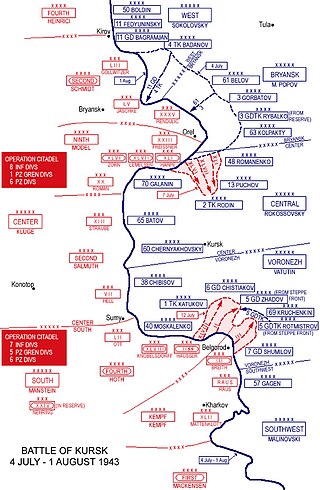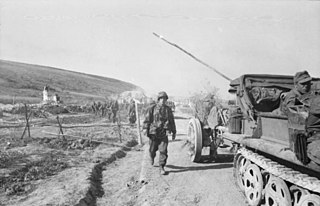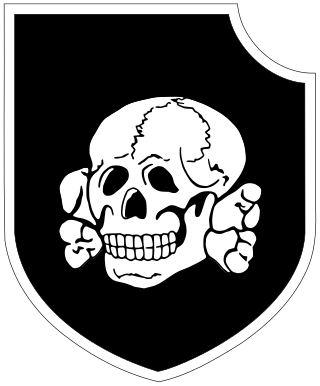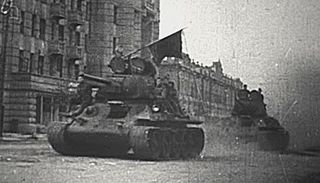
The Battle of Kursk was a major World War II Eastern Front battle between the forces of Germany and the Soviet Union near Kursk in southwestern Russia during the summer of 1943; it ultimately became the largest tank battle in history and resulted in a Soviet victory. It, along with the Battle of Stalingrad several months earlier, are the two most oft-cited turning points in the European theatre of the war preceding the total Allied victory two years later.

Operation Goodwood was a British offensive during the Second World War, which took place between 18 and 20 July 1944 as part of the larger battle for Caen in Normandy, France. The objective of the operation was a limited attack to the south, from the Orne bridgehead, to capture the rest of Caen and the Bourguébus Ridge beyond.

The Panzerkampfwagen IV, commonly known as the Panzer IV, is a German medium tank developed in the late 1930s and used extensively during the Second World War. Its ordnance inventory designation was Sd.Kfz. 161.

The Panther tank, officially Panzerkampfwagen V Panther with ordnance inventory designation: Sd.Kfz. 171, is a German medium tank of World War II. It was used on the Eastern and Western Fronts from mid-1943 to the end of the war in May 1945.

Operation Citadel was the German offensive operation in July 1943 against Soviet forces in the Kursk salient, proposed by Generalfeldmarschall Fritz Erich Georg Eduard von Manstein during the Second World War on the Eastern Front that initiated the Battle of Kursk. The deliberate defensive operation that the Soviets implemented to repel the German offensive is referred to as the Kursk Strategic Defensive Operation. The German offensive was countered by two Soviet counter-offensives, Operation Polkovodets Rumyantsev and Operation Kutuzov. For the Germans, the battle was the final strategic offensive that they were able to launch on the Eastern Front. As the Allied invasion of Sicily began, Adolf Hitler was forced to divert troops training in France to meet the Allied threats in the Mediterranean, rather than use them as a strategic reserve for the Eastern Front. Germany's extensive loss of men and tanks ensured that the victorious Soviet Red Army enjoyed the strategic initiative for the remainder of the war.

The Sturmpanzer is a German armoured infantry support gun based on the Panzer IV chassis used in the Second World War. It was used at the Battles of Kursk, Anzio, Normandy, and was deployed in the Warsaw Uprising. It was known by the nickname Brummbär by Allied intelligence, a name which was not used by the Germans. German soldiers nicknamed it the "Stupa", a contraction of the term Sturmpanzer. Just over 300 vehicles were built and they were assigned to four independent battalions.

Nazi Germany developed numerous tank designs used in World War II. In addition to domestic designs, Germany also used various captured and foreign-built tanks.

The 3rd SS Panzer Division "Totenkopf" was an elite division of the Waffen-SS of Nazi Germany during World War II, formed from the Standarten of the SS-TV. Its name, Totenkopf, is German for "death's head" – the skull and crossbones symbol – and it is thus sometimes referred to as the Death's Head Division.

The 2nd Panzer Division was an armoured division in the German Army, the Heer, during World War II.

The 9th Panzer Division was a panzer division of the German Army during World War II. It came into existence after 4th Light Division was reorganized in January 1940. The division was headquartered in Vienna, in the German military district Wehrkreis XVII.

The 4th Panzer Division was an armored division in the Army of Nazi Germany.

The Battle of Prokhorovka was fought on 12 July 1943 near Prokhorovka, 87 kilometres (54 mi) southeast of Kursk, in the Soviet Union, during the Second World War. Taking place on the Eastern Front, the engagement was part of the wider Battle of Kursk and occurred when the 5th Guards Tank Army of the Soviet Red Army attacked the II SS-Panzer Corps of the German Waffen-SS in one of the largest tank battles in history.
The Pakfront was a defensive military tactic developed by the German forces on the Eastern Front during the Second World War. It was named after the phonetic pronunciation of the acronym nomenclature for German towed anti-tank guns, PaK. The Soviets soon copied the tactic, and used it to great effect at the Battle of Kursk in July 1943.

Operation Kutuzov was the first of the two counteroffensives launched by the Red Army as part of the Kursk Strategic Offensive Operation. It commenced on 12 July 1943, in the Central Russian Upland, against Army Group Center of the German Heer. The operation was named after General Mikhail Kutuzov, the Russian general credited with saving Russia from Napoleon during the French invasion of Russia in 1812. Operation Kutuzov was one of two large-scale Soviet operations launched as counteroffensives against Operation Citadel. The Operation began on 12 July and ended on 18 August 1943 with the capture of Orel and collapse of the Orel bulge.

The 25th Panzer Division was a tank formation of the German Army during World War II. It was one of several understrength Panzer divisions formed during the last years of the war.

The Belgorod–Kharkov strategic offensive operation, or simply Belgorod–Kharkov offensive operation, was a Soviet strategic summer offensive that aimed to recapture Belgorod and Kharkov, and destroy Nazi German forces of the 4th Panzer Army and Army Detachment Kempf. The operation was codenamed Operation Polkovodets Rumyantsev, after the 18th-century Field Marshal Peter Rumyantsev and was conducted by the Voronezh and Steppe Fronts in the southern sector of the Kursk Bulge. The battle was referred to as the Fourth Battle of Kharkov by the Germans.
The Mirgorod direction offensive was an operation conducted as part of Operation Polkovodets Rumyantsev between the Red Army and Wehrmacht forces. It was one of the operations that followed the Battle of Kursk. In the offensive, the Red Army pushed through the Wehrmacht lines after the Wehrmacht retreated after the Battle of Kursk. It represented a turning point on the Eastern Front.

This article deals with the tanks serving in the German Army throughout history, such as the World War I tanks of the Imperial German Army, the interwar and World War II tanks of the Nazi German Wehrmacht, the Cold War tanks of the West German and East German Armies, all the way to the present day tanks of the Bundeswehr.

Operation Roland was a local German offensive inside the Soviet Union during the Second World War on the Eastern Front, and was conducted as a local operation within the overarching German summer offensive, Operation Citadel, on the southern side of the Kursk salient. The German forces of the III Panzer Corps and the 2nd SS Panzergrenadier Division Das Reich of the II SS Panzer Corps attempted to envelop and destroy Soviet forces of the Voronezh Front. This operation was necessitated by the failure of the German II SS Panzer Corps to break through Soviet forces during the Battle of Prokhorovka on 12 July. Therefore, German commanders decided to first link up the III Panzer Corps, which had been lagging behind due to heavy Soviet resistance, with the II SS Panzer Corps, in order to consolidate the German positions into a continuous frontline without inward bulges and enable the two panzer corps to overrun Soviet forces defending Prokhorovka together. The linking up of the two German pincers was planned to effectuate the envelopment of the Soviet 69th Army and other supporting units.

The IS-2 is a Soviet heavy tank, the second of the IS tank series named after the Soviet leader Joseph Stalin. It was developed and saw combat during World War II and saw service in other Soviet allied countries after the war.


















